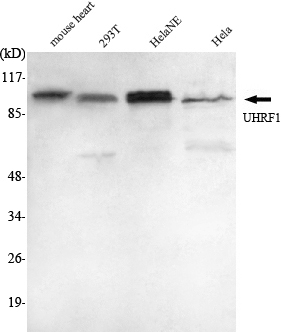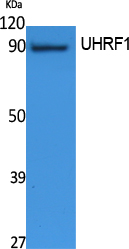UHRF1 Monoclonal Antibody
- Catalog No.:YM1111
- Applications:WB;IF
- Reactivity:Human
- Target:
- UHRF1
- Gene Name:
- UHRF1
- Protein Name:
- E3 ubiquitin-protein ligase UHRF1
- Human Gene Id:
- 29128
- Human Swiss Prot No:
- Q96T88
- Mouse Swiss Prot No:
- Q8VDF2
- Immunogen:
- Purified recombinant human UHRF1 (N-terminus) protein fragments expressed in E.coli.
- Specificity:
- UHRF1 Monoclonal Antibody detects endogenous levels of UHRF1 protein.
- Formulation:
- Liquid in PBS containing 50% glycerol, 0.5% BSA and 0.02% sodium azide.
- Source:
- Monoclonal, Mouse
- Dilution:
- WB 1:1000 - 1:2000. IF 1:100 - 1:500. Not yet tested in other applications.
- Purification:
- Affinity purification
- Concentration:
- 1 mg/ml
- Storage Stability:
- -15°C to -25°C/1 year(Do not lower than -25°C)
- Other Name:
- UHRF1;ICBP90;NP95;RNF106;E3 ubiquitin-protein ligase UHRF1;Inverted CCAAT box-binding protein of 90 kDa;Nuclear protein 95;Nuclear zinc finger protein Np95;HuNp95;hNp95;RING finger protein 106;Transcription factor ICBP90;Ubiquit
- Molecular Weight(Da):
- 90kD
- Background:
- This gene encodes a member of a subfamily of RING-finger type E3 ubiquitin ligases. The protein binds to specific DNA sequences, and recruits a histone deacetylase to regulate gene expression. Its expression peaks at late G1 phase and continues during G2 and M phases of the cell cycle. It plays a major role in the G1/S transition by regulating topoisomerase IIalpha and retinoblastoma gene expression, and functions in the p53-dependent DNA damage checkpoint. It is regarded as a hub protein for the integration of epigenetic information. This gene is up-regulated in various cancers, and it is therefore considered to be a therapeutic target. Multiple transcript variants encoding different isoforms have been found for this gene. A related pseudogene exists on chromosome 12. [provided by RefSeq, Feb 2014],
- Function:
- developmental stage:Expressed in fetal thymus, liver and kidney.,domain:The RING finger is required for ubiquitin ligase activity.,domain:The YDG domain mediates the interaction with histone H3.,function:Putative E3 ubiquitin-protein ligase. May participate in methylation-dependent transcriptional regulation. Binds to inverted 5'-CCAAT-3' box 2 in the TOP2A promoter, and activates TOP2A expression. Important for G1/S transition. May be involved in DNA repair and chromosomal stability.,induction:Up-regulated in proliferating cells, and down-regulated in quiescent cells. Down-regulated upon adriamycin-induced DNA damage, in a TP53/p53 and CDKN1A-dependent way. Induced by E2F1 transcription factor.,pathway:Protein modification; protein ubiquitination.,PTM:Phosphorylated on serine residues. Phosphorylation may enhance DNA-binding activity.,PTM:Ubiquitinated; which leads to proteasomal degrad
- Subcellular Location:
- Nucleus . Localizes to replication foci. Enriched in pericentric heterochromatin. Also localizes to euchromatic regions.
- Expression:
- Expressed in thymus, bone marrow, testis, lung and heart. Overexpressed in breast cancer.
Pi, Jing-Ting, et al. "Overexpression of UHRF1 is significantly associated with poor prognosis in laryngeal squamous cell carcinoma." Medical oncology 30.4 (2013): 613.
- June 19-2018
- WESTERN IMMUNOBLOTTING PROTOCOL
- June 19-2018
- IMMUNOHISTOCHEMISTRY-PARAFFIN PROTOCOL
- June 19-2018
- IMMUNOFLUORESCENCE PROTOCOL
- September 08-2020
- FLOW-CYTOMEYRT-PROTOCOL
- May 20-2022
- Cell-Based ELISA│解您多样本WB检测之困扰
- July 13-2018
- CELL-BASED-ELISA-PROTOCOL-FOR-ACETYL-PROTEIN
- July 13-2018
- CELL-BASED-ELISA-PROTOCOL-FOR-PHOSPHO-PROTEIN
- July 13-2018
- Antibody-FAQs
- Products Images

- Western Blot analysis using UHRF1 Monoclonal Antibody against mouse heart, 293T, HeLa cell lysate, HeLa nuclear extract.

- Immunofluorescence analysis of HeLa cells using UHRF1 Monoclonal Antibody.


